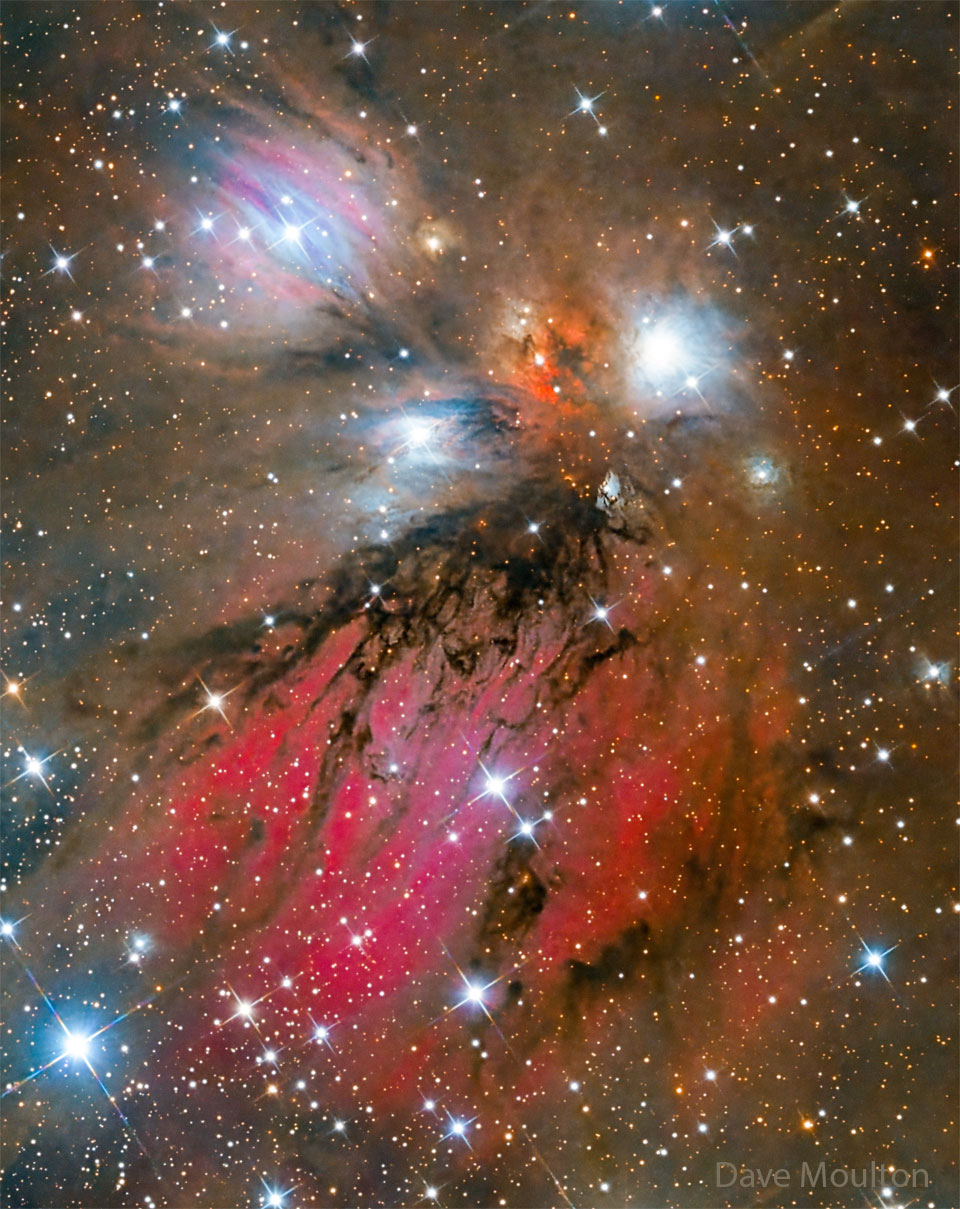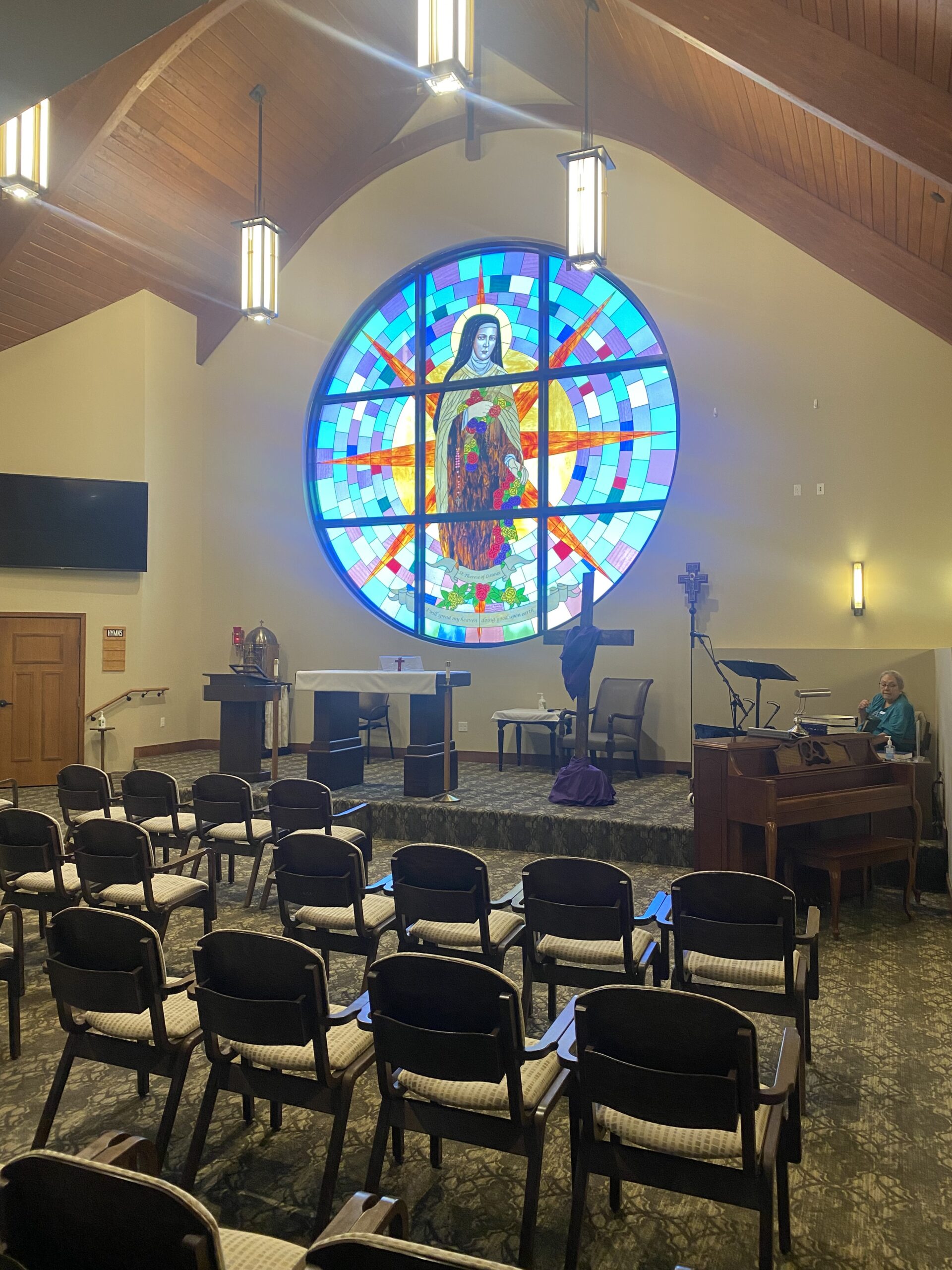A relatively normal galaxy — but seen from its edge. Many disk galaxies are actually just as thin as NGC 5866, the Spindle galaxy, pictured here, but are not seen edge-on from our vantage point. A perhaps more familiar galaxy seen edge-on is our own Milky Way galaxy. Also cataloged as M102, the Spindle galaxy has numerous and complex dust lanes appearing dark and red, while many of the bright stars in the disk give it a more blue underlying hue. The blue disk of young stars can be seen in this Hubble image extending past the dust in the extremely thin galactic plane. There is evidence that the Spindle galaxy has cannibalized smaller galaxies over the past billion years or so, including multiple streams of faint stars, dark dust that extends away from the main galactic plane, and a surrounding group of galaxies (not shown). In general, many disk galaxies become thinbecause the gas that forms them collides with itself as it rotates about the gravitational center. The Spindle galaxy lies about 50 million light years distant toward the constellation of the Dragon (Draco).

see full post...
David Jon Gilmour CBE born 6 March 1946 is an English musician, singer and songwriter, who is a member of the rock band Pink Floyd. He joined as guitarist and co-lead vocalist in 1967, shortly before the departure of founding member Syd Barrett. Pink Floyd achieved international success with the concept albums The Dark Side of the Moon (1973), Wish You Were Here (1975), Animals(1977), The Wall (1979) and The Final Cut (1983). By the early 1980s, they had become one of the highest-selling and most acclaimed acts in music history; by 2012, they had sold more than 250 million records worldwide, including 75 million in the United States. Following the departure of Roger Waters in 1985, Pink Floyd continued under Gilmour’s leadership and released three more studio albums.
see full post...Flora Purim (born March 6, 1942) is a Brazilian jazz singer known primarily for her work in the jazz fusion style. She became prominent for her part in Return to Forever with Chick Corea and Stanley Clarke. She has recorded and performed with numerous artists, including Dizzy Gillespie, Gil Evans, Opa, Stan Getz, George Duke, Mickey Hart of the Grateful Dead, Santana, Jaco Pastorius, and her husband Airto Moreira.
In 2002, Purim was the recipient of one of Brazil’s highest awards, the 2002 Ordem do Rio Branco for Lifetime Achievement. She has been called “The Queen of Brazilian Jazz”.
Purim was born in Rio de Janeiro, Brazil, to Jewish parents who were classical musicians. Her father Naum Purim played violin and her mother Rachel Vaisberg was a pianist. When her father was out of the house, her mother played jazz.
see full post...John Leslie “Wes” Montgomery (March 6, 1923 – June 15, 1968) was an American jazz guitarist. Montgomery was known for his unusual technique of plucking the strings with the side of his thumb, and for his extensive use of octaves, which gave him a distinctive sound.
Montgomery often worked with his brothers Buddy (Charles F.) and Monk (William H.) and with organist Melvin Rhyne. His recordings up to 1965 were oriented towards hard bop, soul jazz, and post bop, but around 1965 he began recording more pop-oriented instrumental albums that found mainstream success. His later guitar style influenced jazz fusion and smooth jazz.
Montgomery was born in Indianapolis, Indiana. According to NPR, the nickname “Wes” was a child’s abbreviation of his middle name, Leslie. The family was large, and the parents split up early in the lives of the children. Montgomery and his brothers moved to Columbus, Ohio, with their father and attended Champion High School. Montgomery died of a heart attack on June 15, 1968, while at home in Indianapolis. He was 45 years old.
see full post...
Howard McGhee (March 6, 1918 – July 17, 1987) was one of the first American bebop jazz trumpeters, with Dizzy Gillespie, Fats Navarro and Idrees Sulieman. He was known for his fast fingering and high notes. He had an influence on younger bebop trumpeters such as Fats Navarro.
Howard McGhee was born in Tulsa, Oklahoma, United States, and raised in Detroit, Michigan.
During his career, he played in bands led by Lionel Hampton, Andy Kirk, Count Basie and Charlie Barnet. He was in a club listening to the radio when he first heard Charlie Parker and was one of the earliest adopters of the new style, a fact that was disapproved by older musicians like Kid Ory.
In 1946–1947, some record sessions for the new label Dial were organized in Hollywood, with Charlie Parker and McGhee. The first was held on July 29, 1946. The musicians were Charlie Parker, Howard McGhee, Jimmy Bunn, Bob Kesterson, and Roy Porter. With Parker’s health near to collapse, he played “Max is Making Wax”, “Lover Man“, and “The Gypsy”
see full post...James Robert Wills (March 6, 1905 – May 13, 1975 Kosse, TX) was an American Western swing musician, songwriter, and bandleader. Considered by music authorities as the founder of Western swing, he was known widely as the King of Western Swing (although Spade Cooley self-promoted the moniker “King of Western Swing” from 1942 to 1969). He was also noted for punctuating his music with his trademark “ah-haa” calls.
Wills formed several bands and played radio stations around the South and West until he formed the Texas Playboys in 1934 with Wills on fiddle, Tommy Duncan on piano and vocals, rhythm guitarist June Whalin, tenor banjoist Johnnie Lee Wills, and Kermit Whalin who played steel guitar and bass. Oklahoma guitar player Eldon Shamblin joined the band in 1937 bringing jazzy influence and arrangements. The band played regularly on Tulsa, Oklahoma, radio station KVOO and added Leon McAuliffe on steel guitar, pianist Al Stricklin, drummer Smokey Dacus, and a horn section that expanded the band’s sound. Wills favored jazz-like arrangements and the band found national popularity into the 1940s with such hits as “Steel Guitar Rag“, “San Antonio Rose“, “Smoke on the Water“, “Stars and Stripes on Iwo Jima“, and “New Spanish Two Step“.
Wills and the Texas Playboys recorded with several publishers and companies, including Vocalion, Okeh, Columbia, and MGM. In 1950, Wills had two top 10 hits, “Ida Red likes the Boogie” and “Faded Love“, which were his last hits for a decade. Throughout the 1950s, he struggled with poor health and tenuous finances. He continued to perform frequently despite a decline in the popularity of his earlier hit songs, and the growing popularity of rock and roll. Wills had a heart attack in 1962, and a second one the next year, which forced him to disband the Texas Playboys. Wills continued to perform solo.
see full post...In this celestial abstract art composed with a cosmic brush, dusty nebula NGC 2170, also known as the Angel Nebula, shines just above the image center. Reflecting the light of nearby hot stars, NGC 2170 is joined by other bluish reflection nebulae, a red emission region, many dark absorption nebulae, and a backdrop of colorful stars. Like the common household items that abstract painters often choose for their subjects, the clouds of gas, dust, and hot stars featured here are also commonly found in a setting like this one — a massive, star-forming molecular cloud in the constellation of the Unicorn (Monoceros). The giant molecular cloud, Mon R2, is impressively close, estimated to be only 2,400 light-years or so away. At that distance, this canvas would be over 60 light-years across.

J. B. Lenoir (March 5, 1929 – April 29, 1967) was an American blues guitarist and singer-songwriter, active in the Chicago blues scene in the 1950s and 1960s.
Lenoir was born in Monticello, Mississippi. His full given name was simply “J. B.”; the letters were not initials. Lenoir’s guitar-playing father introduced him to the music of Blind Lemon Jefferson, which became a major influence. During the early 1940s, Lenoir worked with the blues artists Sonny Boy Williamson II and Elmore James in New Orleans. He was later influenced by Arthur Crudup and Lightnin’ Hopkins.
Lenoir died on April 29, 1967, in Urbana, Illinois, at the age 38, of injuries he had suffered in a car crash three weeks earlier.
see full post...Louis A. “Lou” Levy (March 5, 1928 – January 23, 2001) was an American jazz pianist.
Levy was born to Jewish parents in Chicago, Illinois, United States, and started to play the piano aged twelve. His chief influences were Art Tatum and Bud Powell.
A professional at age nineteen, Levy played with Georgie Auld (1947 and later), Sarah Vaughan, Chubby Jackson (1947–1948), Boyd Raeburn, Woody Herman’s Second Herd (1948–1950), Tommy Dorsey (1950) and Flip Phillips. Levy left music for a few years in the early 1950s and then returned to gain a strong reputation as an accompanist to singers, working with Peggy Lee (1955–1973), Ella Fitzgerald (1957–1962), June Christy, Anita O’Day and Pinky Winters. Levy also played with Dizzy Gillespie, Shorty Rogers, Stan Getz, Terry Gibbs, Benny Goodman, Supersax and most of the major West Coast players.Levy recorded as a leader for Nocturne (1954), RCA, Jubilee, Philips, Interplay (1977), and Verve.
Levy died of a heart attack in Dana Point, California at the age of 72
see full post...

Here we see NGC 4423, a galaxy that lies about 55 million light-years away in the constellation Virgo. In this image NGC 4423 appears to have quite an irregular, tubular form, so it might be surprising to find out that it is in fact a spiral galaxy. Knowing this, we can make out the denser central bulge of the galaxy, and the less crowded surrounding disc (the part that comprises the spiral arms). If NGC 4423 were viewed face-on it would resemble the shape that we most associate with spiral galaxies: the spectacular curving arms sweeping out from a bright centre, interspersed with dimmer, darker, less populated regions. But when observing the skies we are constrained by the relative alignments between Earth and the objects that we are observing: we cannot simply reposition Earth so that we can get a better face-on view of NGC 4423! Of course, celestial objects do not remain sedentary in space, but often move at extremely rapid velocities relative to one another. This might suggest that, should a galaxy be moving in a fortuitous direction relative to Earth, we might be able to view it from a substantially different perspective once it has moved far enough. This is theoretically possible, but the reality is that the distances in space are simply far too big, and human lifetimes far too short, for a noticeable difference in relative alignment to occur. In other words, this is more-or-less the view of NGC 4423 that we will always have! [Image Description: A broad spiral galaxy is seen edge-on, so that its spiral arms can’t be seen. Visible dust and stars trace the disc of the galaxy, surrounded by a glowing halo above and below. The colour of the galaxy changes smoothly between the outer disc at the ends and the bulge in the centre. A few bright stars surround the galaxy on a dark background.]

Ricky Ford (born March 4, 1954) is an American jazz tenor saxophonist.
Ford was born in Boston, Massachusetts, United States,) and studied at the New England Conservatory. In 1974, he recorded with Gunther Schuller and then played in the Duke Ellington Orchestra under Mercer Ellington from 1974 to 1976. After this he played with Charles Mingus (1976–77), Dannie Richmond (1978–81), Lionel Hampton (1980–82), and then in the Mingus Dynasty (1982). He also played with Abdullah Ibrahim (1983–90) and Mal Waldron (1989–94), and has recorded with many other notable musicians including Yusef Lateef, Sonny Stitt, McCoy Tyner, Freddie Hubbard, Amina Claudine Myers, Sathima Bea Benjamin, Steve Lacy, and others.
see full post...Robert Dwayne Womack (/ˈwoʊmæk/; March 4, 1944 – June 27, 2014) was an American singer, musician and songwriter. Starting in the early 1950s as the lead singer of his family musical group the Valentinos and as Sam Cooke‘s backing guitarist, Womack’s career spanned more than 60 years and multiple styles, including R&B, jazz, soul, rock and roll, doo-wop, and gospel.
Womack was a prolific songwriter who wrote and originally recorded, (with his brothers, the Valentinos), the Rolling Stones‘ first UK number one hit (“It’s All Over Now“) and New Birth‘s “I Can Understand It“. As a singer, he is most notable for the hits “Lookin’ for a Love“, “That’s the Way I Feel About Cha“, “Woman’s Gotta Have It“, “Harry Hippie“, “Across 110th Street“, and his 1980s hits “If You Think You’re Lonely Now” and “I Wish He Didn’t Trust Me So Much“.
In 2009, Womack was inducted into the Rock and Roll Hall of Fame.
Womack was born in Cleveland‘s Fairfax neighborhood, near East 85th Street and Quincy Avenue, to Naomi Womack and Friendly Womack, the third of five sons. Friendly Jr. and Curtis were Bobby’s older brothers, and Harry and Cecil were his younger brothers. They all grew up in the Cleveland slums, so poor that the family would fish pig snouts out of the local supermarket’s trash. He had to share a bed with his brothers. His mother told him he could “sing his way out of the ghetto.” Recalling his childhood, Bobby said, “we came up very poor. My kids have had a much better life than I’d ever thought of livin,'” and, “the neighborhood was so ghetto that we didn’t bother the rats and they didn’t bother us.
see full post...Jan Garbarek (born 4 March 1947) is a Norwegian jazz saxophonist, who is also active in classical music and world music.
Garbarek was born in Mysen, Østfold, southeastern Norway, the only child of a former Polish prisoner of war, Czesław Garbarek, and a Norwegian farmer’s daughter. He grew up in Oslo, stateless until the age of seven, as there was no automatic grant of citizenship in Norway at the time. When he was 21, he married the author Vigdis Garbarek. He is the father of musician and composer Anja Garbarek.
Garbarek’s style incorporates a sharp-edged tone, long, keening, sustained notes, and generous use of silence. He began his recording career in the late 1960s, notably featuring on recordings by the American jazz composer George Russell (such as Electronic Sonata for Souls Loved by Nature). By 1973 he had turned his back on the harsh dissonances of avant-garde jazz, retaining only his tone from his previous approach. Garbarek gained wider recognition through his work with pianist Keith Jarrett‘s European Quartet which released the albums Belonging (1974), My Song (1977), and the live recordings Personal Mountains(1979), and Nude Ants (1979). He was also a featured soloist on Jarrett’s orchestral works Luminessence (1974) and Arbour Zena (1975).
see full post...Zenzile Miriam Makeba (4 March 1932 – 9 November 2008), nicknamed Mama Africa, was a South African singer, songwriter, actress, and civil rights activist. Associated with musical genres including Afropop, jazz, and world music, she was an advocate against apartheid and white-minority government in South Africa.
Born in Johannesburg to Swazi and Xhosa parents, Makeba was forced to find employment as a child after the death of her father. She had a brief and allegedly abusive first marriage at the age of 17, gave birth to her only child in 1950, and survived breast cancer. Her vocal talent had been recognized when she was a child, and she began singing professionally in the 1950s, with the Cuban Brothers, the Manhattan Brothers, and an all-woman group, the Skylarks, performing a mixture of jazz, traditional African melodies, and Western popular music. In 1959, Makeba had a brief role in the anti-apartheid film Come Back, Africa, which brought her international attention, and led to her performing in Venice, London, and New York City. In London, she met the American singer Harry Belafonte, who became a mentor and colleague. She moved to New York City, where she became immediately popular, and recorded her first solo album in 1960. Her attempt to return to South Africa that year for her mother’s funeral was prevented by the country’s government.
Makeba’s career flourished in the United States, and she released several albums and songs, her most popular being “Pata Pata” (1967). Along with Belafonte, she received a Grammy Award for Best Folk Recording for their 1965 album An Evening with Belafonte/Makeba. She testified against the South African government at the United Nations and became involved in the civil rights movement. She married Stokely Carmichael, a leader of the Black Panther Party, in 1968, and consequently lost support among white Americans. Her visa was revoked by the US government when she was traveling abroad, forcing her and Carmichael to relocate to Guinea. She continued to perform, mostly in African countries, including at several independence celebrations. She began to write and perform music more explicitly critical of apartheid; the 1977 song “Soweto Blues“, written by her former husband Hugh Masekela, was about the Soweto uprising. After apartheid was dismantled in 1990, Makeba returned to South Africa. She continued recording and performing, including a 1991 album with Nina Simone and Dizzy Gillespie, and appeared in the 1992 film Sarafina!. She was named an FAO Goodwill Ambassador in 1999, and campaigned for humanitarian causes. She died of a heart attack during a 2008 concert in Italy.
Makeba was among the first African musicians to receive worldwide recognition. She brought African music to a Western audience, and popularized the world music and Afropop genres. Despite her cosmopolitan background, she was frequently viewed by Western audiences as an embodiment of Africa: she was also seen as a style icon in both South Africa and the West. Makeba made popular several songs critical of apartheid, and became a symbol of opposition to the system, particularly after her right to return was revoked. Upon her death, former South African President Nelson Mandela said that “her music inspired a powerful sense of hope in all of us.”
see full post...